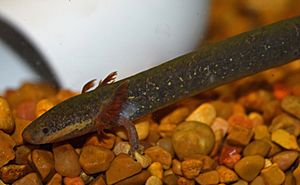Lesser siren facts for kids
Quick facts for kids Lesser siren |
|
|---|---|
 |
|
| Conservation status | |
| Scientific classification | |
| Genus: |
Siren
|
| Species: |
intermedia
|
The lesser siren (Siren intermedia) is a type of salamander that lives in water. You can find them in the eastern United States and northern Mexico. People call them by many names, like "two-legged eel" or "mud eel." Their name intermedia means they are a medium size. They are bigger than dwarf sirens but smaller than greater sirens.
Contents
What Do Lesser Sirens Do?
Lesser sirens are nocturnal, which means they are active at night. During the day, they hide in mud or plants at the bottom of slow-moving water.
They mostly eat small water creatures without backbones, called invertebrates. This includes worms, bug larvae, snails, and crustaceans like tiny shrimp. They also eat the tadpoles and eggs of other amphibians.
Lesser Siren Reproduction
Lesser sirens lay their eggs in the spring. They put them in shallow spots in calm water, often near plants. Scientists don't know much about how they find partners. But it seems like they can be a bit rough, as some sirens have bite marks from others. A female can lay between 12 and 300 eggs at once. They might lay several groups of eggs throughout the year. Baby sirens are very tiny when they hatch, only about 0.4 inches (1.1 cm) long. But they grow fast! They become adults in three to four years.
Unlike most salamanders, lesser sirens can make sounds. They make clicking noises when they get close to other sirens. If someone picks them up, they might make a short screeching sound.
Surviving Dry Times
If their habitat (the place where they live) dries up in the summer, lesser sirens have a cool trick. They can dig into the mud and stay there. If the mud gets completely dry, they can make a special goo from their skin. This goo keeps them from drying out. They can stay buried in dry mud for months until the water comes back. Their small legs also let them move on dry land for short times.
What Do Lesser Sirens Look Like?
Lesser sirens have long, skinny bodies. They only have two legs, which are small and have four toes. These legs are located right behind their heads. Lesser sirens can be from 7 to 27 inches (17 to 69 cm) long.
Young sirens have red or yellow bands on their heads and stripes along their bodies. However, one type, Siren i. intermedia, doesn't have these stripes. Adult sirens have plainer colors. Their backs are usually olive green, blue-gray, or black. Their bellies are often light gray. Some adults might also have spots.
Lesser sirens are special because they keep their external gills their whole lives. Most amphibians lose their gills as they grow up.
Where Do Lesser Sirens Live?
You can find lesser sirens in the United States and Mexico. In the U.S., they live from Virginia down to Florida, and west to Texas. They also live in northeastern Mexico, as far south as Veracruz. Northward, they can be found up to Illinois and southwest Michigan. It's exciting because some lesser sirens were recently found again in Michigan after not being seen there for 60 years!
Different Kinds of Lesser Sirens
Scientists sometimes disagree on how many different types, or subspecies, of lesser sirens there are. Most agree there are at least two main types: an eastern one and a western one. Many also include a third type, the Rio Grande lesser siren.
Some researchers think the Rio Grande type might be its own species. Others think it belongs with the greater sirens. It's a bit of a puzzle for scientists!
Here are the main types:
- Eastern lesser siren, S. i. intermedia
- Western lesser siren, S. i. nettingi
- Rio Grande lesser siren, S. i. texana
Are Lesser Sirens Safe?
Lesser sirens are quite common in most places where they live. But you don't see them often because they are very good at hiding.
Like almost all amphibians, their numbers might be going down. This is often because water quality is getting worse. Things like pesticides and fertilizers from farms can wash into their water. People also sometimes catch them to use as bait for fishing.
The species was once thought to be completely gone from Michigan. But luckily, a few have been found there again recently. The S. i. texana subspecies is listed as a threatened species in Texas. Overall, the lesser siren is listed as "Least Concern" on the IUCN Red List. This means they are not currently in danger of disappearing. In Mexico, they have "Special Protection."
See also
 In Spanish: Sirena menor para niños
In Spanish: Sirena menor para niños



